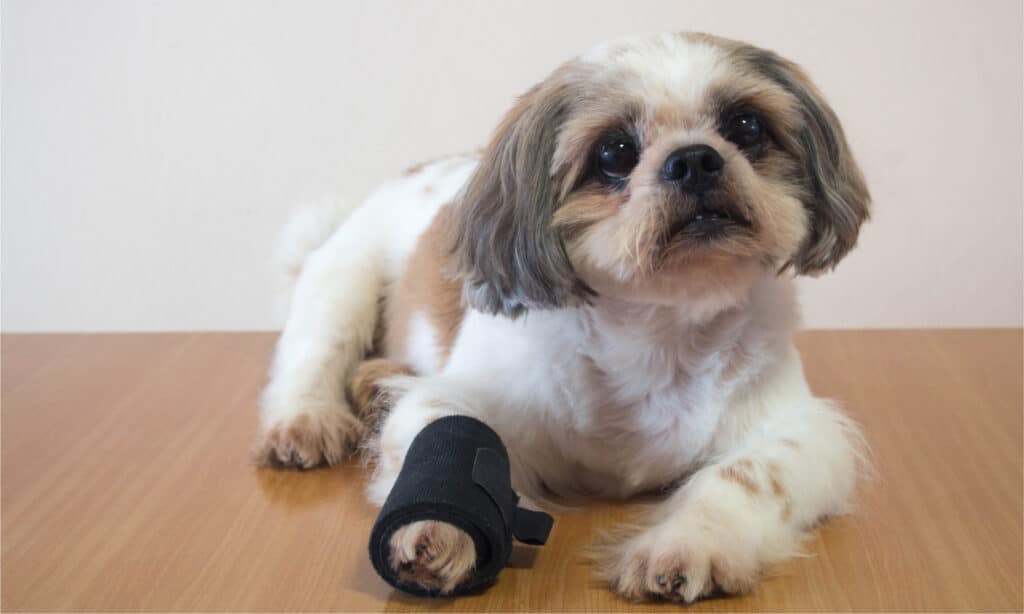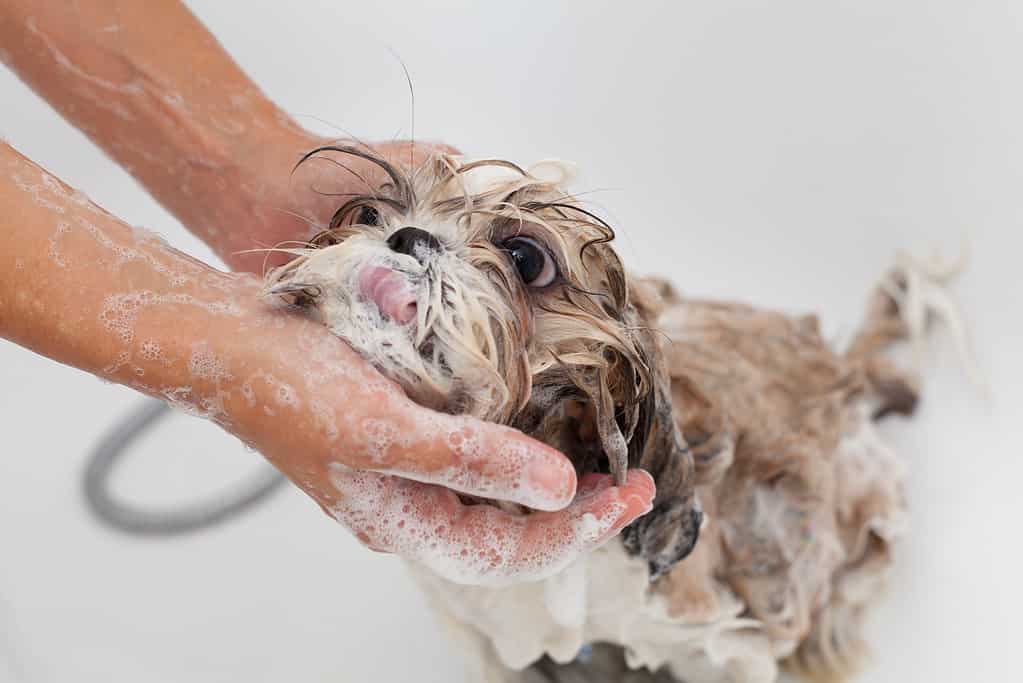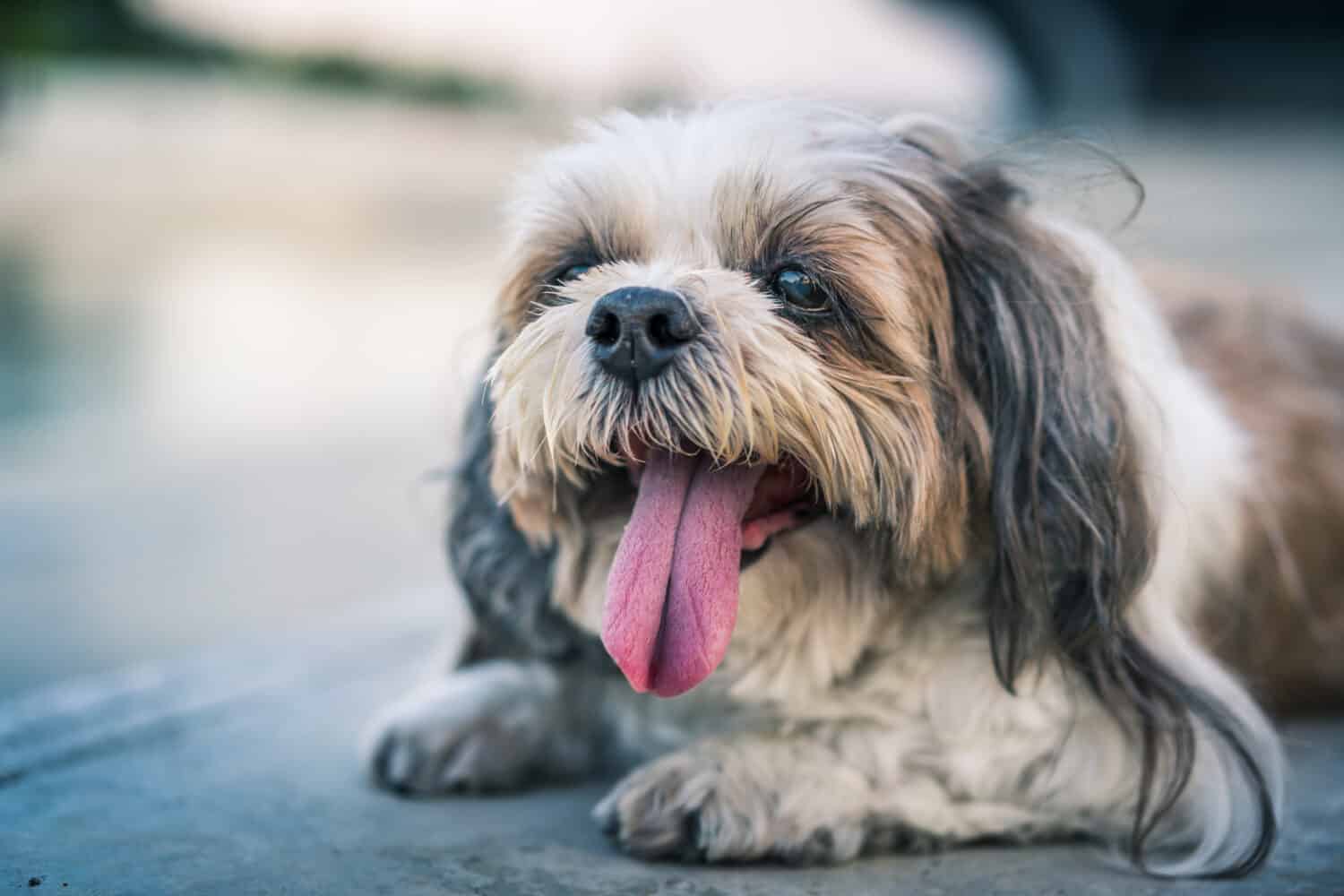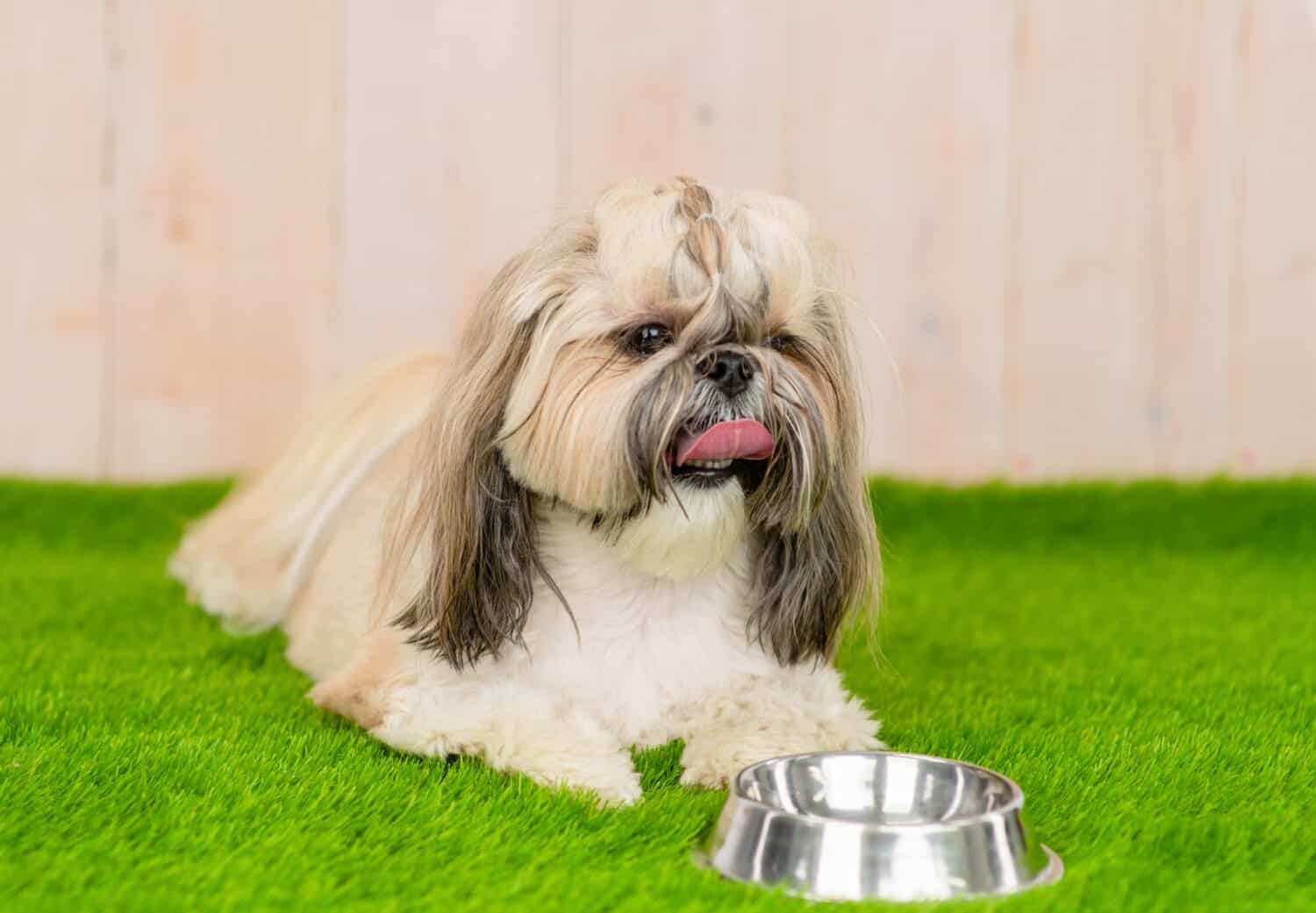If you’re an owner of a shih tzu or you are considering getting one, it’s important to understand the common health issues that may affect this breed. These lovable and loyal companions, unfortunately, may be susceptible to a range of health problems.
In this article, we will guide you through these health concerns, ensuring that your cherished pet is well-taken care of and lives a fulfilling and healthy life. Understanding these issues can help you keep your shih tzu in optimal health!

1. Brachycephalic Airway Obstruction Syndrome (BAOS)

Shih tzus have short noses with narrow airways. This can lead to several breathing issues, including Brachycephalic Airway Obstruction Syndrome.
©Yarnawee Nipatarangkoon/Shutterstock.com
One of the most common health problems in shih tzus is Brachycephalic Airway Obstruction Syndrome (BAOS). This is a major health issue linked to the breed’s short-nosed shape. This shape, known as brachycephaly, causes narrow airways, including abnormally narrowed nostrils, long soft palate, and restricted windpipe, leading to severe breathing difficulties and chronic discomfort.
Symptoms include snoring, rapid breathing, and disrupted sleep. Many shih tzus suffer from this lifelong condition, preventing normal activities like running. Diagnosis requires careful examination, sometimes involving X-rays or endoscopy. The issue is genetic, related to the breed’s specific head shape.
Prospective owners should examine puppies and their parents for signs, though completely eliminating the problem seems unlikely without changing the breed standard. Managing BAOS might include surgery or other treatments, but the breed’s compromised respiration continues to be a welfare concern.
2. Patellar Luxation

Due to the small size of their legs, another common problem in shih tzus is floating kneecaps.
©Orawan Pattarawimonchai/Shutterstock.com
Patellar luxation is a frequent issue affecting the hind legs of small dogs, including shih tzus. In this condition, the kneecap, or patella, slips out of its proper place, a phenomenon also referred to as floating kneecaps.
This problem can be present at birth (congenital) or develop as the dog grows (developmental). While an injury can cause this condition, it’s typically inherited and often found in toy breeds, especially those with short or bowed legs, like the shih tzu.
This condition can be very painful for your tiny pups, and in extremely serious cases, amputation might be required to alleviate the pain. That said, most cases of this condition are mild to moderate instances in which surgery or medication can effectively treat the condition, restoring the dog’s health quite quickly.
3. Dental Issues

As tiny dogs with small faces and mouths but with just as many teeth as larger breeds, shih tzus are prone to teeth issues.
©Daz Stock/Shutterstock.com
A shih tzu’s teeth can suffer from various dental problems like tooth decay, bad breath, infections, gum disease, and even tooth loss if not cleaned regularly and properly.
Like many other dog breeds, when your shih tzu eats, plaque combines with bacteria in its mouth. If left unattended for 24 hours, this mixture hardens with saliva, forming tartar near the gums. This buildup can painfully push the gums away from the teeth’s roots.
The compact nature of a shih tzu’s small mouth, crammed with teeth, makes the breed more susceptible to dental issues. Therefore, taking care of your pet’s teeth is vital for their oral health and overall wellness, as dental problems can spread to other organs and eventually cause serious infections.
Using a gentle dog toothbrush and toothpaste, regular brushing, and flossing at home is essential. Annual visits to the vet for professional cleanings, along with providing dental chews, will help maintain good breath and healthy teeth.
4. Eye Problems

Due to their bulging eyes, shih tzus can experience a number of different eye-related health problems.
©iStock.com/Vlad Antonov
Shih tzus are especially susceptible to eye issues because of their shallow eye sockets. Their protruding eyes can lead to retinal detachment, a serious condition.
The breed’s specific genetic makeup, combined with a flat nose, leaves their eyes more exposed, making them more vulnerable to damage and allowing dirt and debris to enter easily. If you notice any changes in your shih tzu’s eyes, you should contact your veterinarian immediately.
Another relatively common condition with shih tzus is known as dry eye, which impairs tear production. If left untreated, dry eye can permanently harm the dog’s ability to produce tears. Symptoms include thick yellow or green discharge that dries and sticks to the eyelids, potentially resulting in corneal scarring in extreme cases.
Since these signs could indicate various eye problems in the shih tzu, accurate diagnosis by a veterinarian is crucial. Treatment typically involves medication to alleviate swelling and combat bacterial infection.
5. Ear Infections

As with many other long-eared dog breeds, ear infections are pretty common in shih tzus.
©Eli S/Shutterstock.com
Shih tzus, like other dog breeds with long ears, are prone to ear infections. When infected, the ears might become foul-smelling, itchy, or filled with a dark discharge. The infections are typically the result of bacteria, yeast, or fungus, but regardless of the cause, they’re a common issue that you can usually resolve pretty quickly.
The breed’s long ears create a warm, moist environment that’s an ideal breeding ground for infections. Ear infections are, therefore, a familiar problem for shih tzus.
A vet will typically diagnose the problem by taking a sample of the ear discharge and examining it under a microscope to identify whether mites, yeast, or bacteria are the culprits. Treatment often involves antibiotics, antifungal, or anti-mite medications that are generally applied directly to the affected area.
6. Skin Allergies

Shih tzus have long hair (if not groomed) which can cause allergens to stay trapped.
©MDV Edwards/Shutterstock.com
Yet another common health problem in shih tzus is skin allergies. Skin allergies occur in shih tzus largely due to their long coat that can trap various allergens. This makes shih tzus particularly prone to this issue.
Signs that your shih tzu is dealing with allergies might include constant itching, biting, or scratching at the irritated area. Symptoms such as hot spots, hair loss, dry and flaky skin, and rashes are typical for this breed when affected by skin allergies.
For quick relief from itching, a vet may suggest a spray that contains immunosuppressive or steroid medications like cyclosporine or hydrocortisone.
7. Bladder Stones

Unfortunately, bladder stones are another unpleasant health problem that can affect the shih tzu breed.
©juergenhu/Shutterstock.com
Shih tzus are more susceptible to bladder stones than many other breeds. This condition can arise due to various factors such as genetic tendencies, urinary tract infections, and the specific makeup of the dog’s urine. Being a small breed, shih tzus are at an increased risk for urinary calculi or stones. Interestingly, calcium oxalate is the most common type of bladder stone found in shih tzus, and 73% of the dogs found with this type of stone are male!
Symptoms of bladder stones in a dog can resemble those of a bladder infection, with frequent and strained urination. A dog with this condition may urinate, move a bit, and then stop to urinate again, repeating this pattern.
Treatment options for bladder stones include surgery, a procedure called urohydropropulsion, and dietary changes, with the approach depending on the stone’s type, location, and the dog’s overall health. If a urinary tract infection is present, antibiotics may also be prescribed.
8. Hip Dysplasia

A common issue that can be either genetic or caused by deterioration is hip dysplasia.
©Intarapong/Shutterstock.com
Hip dysplasia is another frequent and painful condition found in shih tzus, stemming from abnormal development in the hip joints. The signs of this issue can vary in intensity.
Though most affected dogs are born with healthy hips, abnormal growth in the tissues surrounding the joint occurs as the puppy matures, often due to genetic influences. This leads to the bones drifting apart instead of staying firmly in place.
A shih tzu that typically enjoys energetic activities might suddenly show a reduction in activity and movement, shying away from vigorous play. If ignored, the disease can progress to arthritis and, in severe cases, may even render the dog immobile, requiring assistance to move.
A surgical procedure known as FHO can reduce the pain of hip dysplasia. This operation involves removing the “ball” part of the hip joint, allowing the body to form a “false” joint that diminishes the associated discomfort.
9. Intervertebral Disc Disease (IVDD)

Vertebrae issues are also a serious medical condition in shih tzus.
©cynoclub/Shutterstock.com
Intervertebral Disk Disease (IVDD) in dogs, also known as a ruptured, slipped, or herniated disk, is a condition often seen in certain breeds, including shih tzus.
Type I IVDD is quite frequent, especially among shih tzus. This condition happens when the soft, gel-like core of the disk protrudes through its tough outer layer, exerting pressure on the spinal cord. Over time, this core becomes hard and degenerated.
Shih tzus, like other chondrodystrophic breeds characterized by notably short, curved limbs, undergo early disc degeneration. This makes them more vulnerable to IVDD.
For severe cases of IVDD, where rest and medication fail to reduce symptoms, surgery is usually the recommended course of action.
10. Hypothyroidism

One of the most common symptoms of hypothyroidism is weight gain.
©Orawan Pattarawimonchai/Shutterstock.com
Hypothyroidism is a condition where the dog’s metabolism slows down noticeably. For a shih tzu, signs to watch for include weight gain, reduced energy, behavioral changes, a thinning coat with excessive shedding, and the inability to regrow lost hair.
The most common causes of hypothyroidism in dogs are lymphocytic thyroiditis, an immune-related disease, and idiopathic thyroid gland atrophy. Among shih tzus, hypothyroidism is frequently observed, often linked to an underactive thyroid. This condition might be inherited through genetic lines.
Unfortunately, there’s no permanent cure for hypothyroidism. Lifelong treatment with thyroid hormone replacement therapy is necessary to manage the condition.
11. Liver Problems

Shih tzu dogs can also develop liver disease. This can be a serious issue that may cause other life-threatening health problems.
©135pixels/Shutterstock.com
Liver disease in dogs can manifest through various symptoms such as a lack of appetite, vomiting, stomach issues, diarrhea, seizures, fever, blood clotting issues, and a yellowish hue in the skin and eyes.
In Shih tzus, a particular liver disorder known as portosystemic shunt (PSS) is more prevalent. This condition reroutes some of the blood that should flow to the liver, bypassing it and thereby depriving the liver of the necessary blood for proper growth and function.
The causes of liver problems in dogs can vary, ranging from toxins and infections to cancer.
For treating liver infections, antibiotics are usually prescribed. Adjustments to other medications might be necessary, or their dosages may be reduced. For cases involving tumors or cysts, surgery could be an option.
12. Heart Conditions

If you suspect your shih tzu has heart disease, contact your vet immediately to get a diagnosis ASAP.
©Zapp2Photo/Shutterstock.com
Heart failure is a significant concern in older shih tzus, with valve deterioration accounting for three-quarters of heart-related issues in the breed.
The symptoms indicating progressive heart disease in these dogs can include a persistent cough (especially at night), trouble breathing, exercise difficulties, restlessness during sleep, abnormal heart rate, loss of appetite, weight reduction, and episodes of fainting.
Factors such as genetics, aging, and environmental conditions can contribute to heart problems in shih tzus.
Although heart disease is incurable, early detection and proper treatment can allow a dog to continue to enjoy a fulfilling life. Various medications can help manage the symptoms and slow down the disease’s progression, with the best course of action determined by a veterinarian’s assessment of each specific case.
13. Heat Stroke

If your shih tzu is exposed to high temperatures for long periods it may be at risk of heat stroke.
©opalledo/Shutterstock.com
Heatstroke in shih tzus can present symptoms such as intense redness of the gums, strained breathing and excessive panting, general weakness, unresponsiveness, and even collapsing.
The factors that might increase a shih tzu’s risk of heatstroke include being exposed to high temperatures, being very young or old, having excess weight, suffering from heart or lung issues, being flat-nosed (a condition known as brachycephalic syndrome), having a thick and long coat, and not drinking enough water.
Heatstroke is a serious condition that can be more prevalent in shih tzus, particularly those living in hot climates. The breed’s unique facial structure makes them prone to overheating and breathing difficulties in hot weather.
If a shih tzu is experiencing heatstroke, a vet may intervene by reducing the body temperature, possibly using a cold-water enema. Treatment might also involve special dietary recommendations or intravenous fluids until the dog can return to solid food. While most dogs recover, they may become more prone to heatstroke in the future.
14. Obesity

Shih tzus can be at serious risk of health problems if they become overweight.
©Ken Hurst/Shutterstock.com
Becoming overweight might occur in a shih tzu due to several factors, including unbalanced food choices, inadequate walking durations or exercise, or limited overall daily movement.
You can measure a shih tzu’s weight by feeling for the ribs beneath its coat. If you’re unable to feel the ribs, this could be a sign that the dog is carrying excess weight.
Being overweight isn’t just an aesthetic issue for shih tzus; it’s a serious health concern. Obesity can lead to or exacerbate various health problems, such as issues with the joints, metabolic and digestive systems, back discomfort, and even heart conditions.
To help a shih tzu lose weight, a veterinarian will likely advise reducing treats, increasing physical activity, and closely managing meal portions. Feeding the dog a diet that’s rich in protein and low in carbohydrates can also be part of a healthy weight-loss strategy.
15. Cushing’s Disease (Hyperadrenocorticism)

One of the major warning signs of Cushing’s disease is an extreme increase in thirst.
©Ermolaev Alexander/Shutterstock.com
Another health issue that could affect your shih tzu is Cushing’s disease. This disease occurs in your pet’s adrenal glands and develops very slowly over your dog’s life. Cushing’s disease causes a rapid increase in a steroid hormone called cortisol. Symptoms of hyperadrenocorticism are loss of fur, increased appetite, extreme thirst, increased urination, weight gain, and low energy. This disease is more common in shih tzus than it is in many other breeds. This disease is difficult to diagnose, but it is often caused by a small tumor in the adrenal gland.
Veterinarians will generally prescribe oral medications such as Mitotane and trilostane to treat Cushing’s disease. In more extreme cases where the tumor is large, a vet may recommend surgery to remove it to treat the disease.
How to Take Care of Your Shih Tzu
Taking care of a shih tzu to ensure a healthy and happy life involves paying attention to various aspects of its well-being. Here are some tips:
Diet:
- Feed high-quality dog food suitable for the breed’s size and age.
- Avoid human food scraps and monitor weight to prevent obesity.
Exercise:
- Regular, moderate exercise is essential but avoid overexertion.
- Provide toys and engage in interactive play to stimulate their mind.
Training:
- Use positive reinforcement and maintain consistency in commands.
- Socialize your dog early with other pets and people.
Grooming:
- Brush the coat several times a week to prevent tangles.
- Regularly check eyes, ears, and teeth for signs of health issues.
Health Check-ups:
- Regular veterinary visits for vaccinations and preventative care.
- Promptly address any signs of illness like excessive shedding or behavior changes.
Weather Considerations:
- Protect against heatstroke with plenty of shade and water in hot weather.
- Provide a warm, comfortable space during cold weather.
Special Care for Older Shih Tzus:
- Adjust diet and exercise as needed for older dogs.
- Monitor for age-related health issues, such as arthritis or heart disease.
Avoiding Common Health Problems:
- Be mindful of breed-specific issues like hip dysplasia and take preventive measures.
Emotional Well-being:
- Spend quality time with your shih tzu to foster a strong emotional connection.
- Provide a stable environment to reduce stress and anxiety.
By embracing these care practices, you’ll help your shih tzu lead a healthy, happy, and fulfilling life.
Summary of 15 Common Health Problems Seen in Shih Tzus
| Number | Health Problem | Symptoms |
|---|---|---|
| 1 | Brachycephalic Airway Obstruction Syndrome (BAOS) | Tiring easily, snoring, and noisy breathing |
| 2 | Patellar Luxation | Intermittent skipping or limping on the affected leg |
| 3 | Dental Issues | Discolored teeth, bad breath, and bleeding gums |
| 4 | Eye Problems | Redness, discharge from the eyes, and excessive blinking |
| 5 | Ear Infections | Discharge or bad smell from ears, head shaking, and scratching at the affected ear |
| 6 | Skin Allergies | itchy & red skin, scratching, and biting |
| 7 | Bladder Stones | Vomiting, bloody or cloudy urine, and frequent urination |
| 8 | Hip Dysplasia | Limping, difficulty standing up, and unwillingness to exercise |
| 9 | Intervertebral Disc Disease (IVDD) | Unable to walk or exercise and difficulty defecating and urinating |
| 10 | Hypothyroidism | Weight gain, intolerance to cold, and dull hair with excessive shedding |
| 11 | Liver Problems | Weight loss, vomiting, diarrhea, and low energy |
| 12 | Heart Conditions | Rapid breathing, shortness of breath, and lethargic behavior |
| 13 | Heat Stroke | Panting, bright red tongue, drooling, and red or pale gums |
| 14 | Obesity | Difficulty walking or moving, little to no visible waistline, and lethargy |
| 15 | Cushing’s disease | Increase in appetite, urination, and thirst. Loss of hair and energy. |
Ready to discover the top 10 cutest dog breeds in the entire world?
How about the fastest dogs, the largest dogs and those that are -- quite frankly -- just the kindest dogs on the planet? Each day, AZ Animals sends out lists just like this to our thousands of email subscribers. And the best part? It's FREE. Join today by entering your email below.
Thank you for reading! Have some feedback for us? Contact the AZ Animals editorial team.







